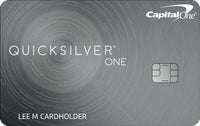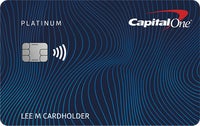Capital One Platinum vs. Capital One QuicksilverOne

The Bankrate promise
At Bankrate we strive to help you make smarter financial decisions. While we adhere to strict , this post may contain references to products from our partners. Here's an explanation for . The content on this page is accurate as of the posting date; however, some of the offers mentioned may have expired. Terms apply to the offers listed on this page. Any opinions, analyses, reviews or recommendations expressed in this article are those of the author’s alone, and have not been reviewed, approved or otherwise endorsed by any card issuer.
Key takeaways
- Both the Capital One Platinum Credit Card and the Capital One QuicksilverOne Cash Rewards Credit Card are geared to individuals with fair credit, which includes FICO scores from 580 to 669.
- The Capital One QuicksilverOne offers rewards for spending, which can add up quickly if you use the card for regular purchases and bills.
- The Capital One Platinum Credit Card doesn't offer any rewards for spending, yet its lack of an annual fee makes it a good choice for the fee-averse.
The Capital One Platinum Credit Card and Capital One QuicksilverOne Cash Rewards Credit Card are both great starter credit cards since they’re geared to people with fair credit scores. While the perks you get with either one are far from generous — and each charges a high APR if you carry a balance — the point of these cards is using them to build credit until you can qualify for a credit card with better benefits and features.
The main factors you should consider when comparing the Capital One Platinum vs. the Capital One QuicksilverOne are annual fees and rewards rates. The Platinum has no annual fee, whereas the QuicksilverOne will cost you $39 per year. The QuicksilverOne offers rewards, though, which may help offset the cost of the annual fee, whereas the Platinum doesn’t have a rewards program. Neither card offers a welcome bonus or a 0 percent introductory APR, either.
Capital One Platinum vs. Capital One QuicksilverOne: At a glance
| Cards | Capital One Platinum Credit Card | Capital One QuicksilverOne Cash Rewards Credit Card |
|---|---|---|
| Welcome bonus | None | None |
| Rewards rate | None | Unlimited 1.5% cash back on all purchases and 5% cash back on hotels and rental cars booked through Capital One Travel |
| Intro APR | None | None |
| Annual fee | $0 | $39 |
Capital One Platinum vs. Capital One QuicksilverOne highlights
Though the differences between the Capital One Platinum and Capital One QuicksilverOne may seem small at first glance, digging deeper into their fine print may help you uncover benefits that could work better for you. Here’s a comparison of each card’s key features to help you decide which one is right for you.
Tie
-
Neither card offers a welcome bonus, so they tie on this factor.

Capital One QuicksilverOne
-
The Capital One Platinum doesn’t offer any rewards for spending, so the QuicksilverOne wins in this category. The QuicksilverOne lets you earn an unlimited 1.5 percent cash back on all of your purchases, which is a solid rewards rate for a credit card for fair credit. You’ll also earn 5 percent back on hotels and rental cars booked through Capital One Travel, which can be helpful if you have upcoming travel plans.

Capital One Platinum
-
The Capital One Platinum doesn’t come with an annual fee, which makes it the clear winner for individuals who don’t want to pay a fee to carry a credit card. Meanwhile, the QuicksilverOne comes with a $39 annual fee that can potentially eat into your rewards earnings. Think of it this way: You would need to make at least $2,600 in purchases with the card to earn your $39 back in rewards each year at a rate of 1.5 percent cash back.
Tie
-
Neither card charges a foreign transaction fee on purchases made in foreign currency, including those made outside the U.S. or via online purchases with foreign-based merchants, so these cards tie in this category.
Which card earns the most?
Since the Capital One Platinum doesn’t offer any rewards for spending, the QuicksilverOne is the clear winner here with its rewards rate of 1.5 percent cash back on every purchase.
However, it’s important to keep the card’s $39 annual fee in mind when calculating how much rewards could benefit you. To help you decide if the QuicksilverOne is right for you, here’s a quick spending example.
Capital One Platinum vs. QuicksilverOne spending example
You’ll need to spend about $217 per month, or $2,600 per year, to make up for the $39 annual fee on the Capital One QuicksilverOne. If you can’t see yourself charging about $217 a month to your card, you may be better off with the Platinum.
Then again, most people could probably make at least $200 in credit card charges per month — and potentially a lot more than that if they used their card to pay for groceries, gas, miscellaneous purchases and bills. The amount of rewards you can earn with the QuicksilverOne is also unlimited, so you’ll earn more cash back the more you spend.
For example, say you spend $1,000 a month ($12,000 per year) with the QuicksilverOne. In that scenario, you would earn $180 in cash back each year, or a profit of $141 after paying the annual fee. If you bump up your spending to $2,000 per month ($24,000 per year), you’ll earn $360 in cash back rewards each year, or a profit of $321 after paying the annual fee.
Why should you get the Capital One Platinum?
If you want the chance to build your credit with a credit card through responsible use, the Platinum card is likely a better option thanks to its lack of an annual fee.
Additional benefits
This card gives you the chance to be automatically considered for a higher credit limit in as little as six months, which is good news for people with limited credit who might start out with a prohibitively low limit. Other benefits include free access to your credit score through CreditWise from Capital One, $0 fraud liability and security alerts whenever Capital One detects suspicious activity on your account. Our Capital One Platinum benefits guide goes over these and other benefits one by one, so make sure to read it over for more details.
Redemption options
The Capital One Platinum doesn’t offer rewards, so there are no redemption options to consider or compare.
Recommended credit score
The recommended credit score for the Platinum is fair or better. According to Capital One, fair credit is defined as having a limited credit history or having defaulted on a loan within the last five years.
Why should you get the Capital One QuicksilverOne?
If you want to build credit with a credit card — and you plan to put more than $217 per month on your card — the Capital One QuicksilverOne can be a good choice.
Additional benefits
Similar to the Capital One Platinum, the QuicksilverOne will automatically consider you for a higher credit line in as little as six months. The card also comes with free access to your credit score through CreditWise, $0 fraud liability and access to Capital One Travel.
Cardholders also get six months of Uber One membership through Nov. 14, 2024, although enrollment is required.
Redemption options
The Capital One QuicksilverOne lets you redeem your cash back rewards for statement credits, checks, recent purchases or gift cards. Since you can redeem rewards for several flexible options, this means you’re unlikely to get “stuck” with rewards you can’t use.
Recommended credit score
Capital One recommends that applicants have at least a fair credit score to qualify for the QuicksilverOne.
The bottom line
If you have a fair credit score or your credit history is limited in general, signing up for the Capital One Platinum or the Capital One QuicksilverOne can help you change that. That said, you do need to decide whether you want to earn rewards or skip paying an annual fee, since that’s the main factor that differentiates these two cards.
No matter what you decide, note that these cards are not ones you’ll want to use to carry a balance due to their high APRs. In fact, both charge a 29.99 percent variate rate that can make carrying debt on them an incredibly costly experience.
Related Articles



